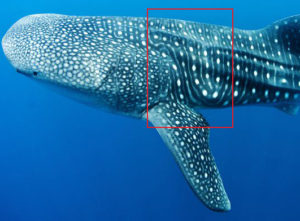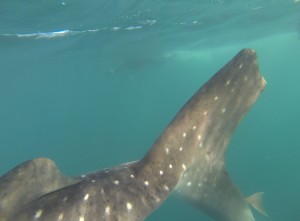- Photo identification
 The spots and stripes pattern of a whale shark is unique to each individual much like the fingerprint of a human being. This whale shark ‘fingerprint’ does not change as the animal grows which means we can monitor the movements of individuals between localities, make estimates of abundance, study population dynamics and evaluate site fidelity. The accepted ‘standard fingerprint’ is the area between the fifth gill slit and the first dorsal fin as shown in the photograph. We maintain our own photo identification library and newly discovered whale sharks are also uploaded to the Wildbook for Whale Sharks, a Wild Me project engineered by Jason Holmberg which consists of a global whale shark database and visual library of whale shark encounters. The database is maintained by marine biologists and citizen scientists from across the globe and the information is used for collaborative research to better understand and protect the species.
The spots and stripes pattern of a whale shark is unique to each individual much like the fingerprint of a human being. This whale shark ‘fingerprint’ does not change as the animal grows which means we can monitor the movements of individuals between localities, make estimates of abundance, study population dynamics and evaluate site fidelity. The accepted ‘standard fingerprint’ is the area between the fifth gill slit and the first dorsal fin as shown in the photograph. We maintain our own photo identification library and newly discovered whale sharks are also uploaded to the Wildbook for Whale Sharks, a Wild Me project engineered by Jason Holmberg which consists of a global whale shark database and visual library of whale shark encounters. The database is maintained by marine biologists and citizen scientists from across the globe and the information is used for collaborative research to better understand and protect the species.
- Injury analysis
It is common knowledge that over 60% of the whale sharks in La Paz bay have visible boat-caused scarring . Often when new, un-scarred sharks are identified in the bay, later encounters show that some are inflicted with boat injuries within weeks or months of their arrival. The injury analysis data, including video footage and photos, give us the opportunity to raise awareness and improve training with local whale shark tour operators. We are looking to back up this study with some behavioural data in the near future (see behavioural studies below).

